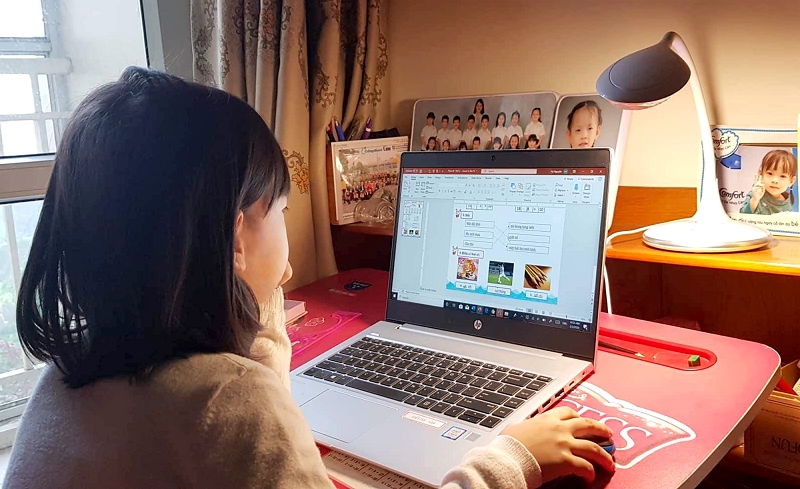Educational institutions utilising e-learning courses
 |
| Educational institutions utilising e-learning courses |
In order to protect students’ health amid the current coronavirus (COVID-19) epidemic, the Ministry of Education and Training decided to allow students at all levels to have three weeks off until February 23. If the health emergency lasts longer, the layover might be even longer.
However, the current situation offers a chance for e-learning to show off its qualities as many universities, schools, and educational centres already apply this platform.
Le Viet Thuy, director of the Information Technology Application Centre under the National Economics University, said that the university has just trained more than 800 lecturers on applying IT and learning management systems (LMS), as well as other blended learning methods for the over 25,000 students of the university.
Vu Trong Nghia, head of the Communication Department at the university, also said that on February 10, 220 teachers of the university used blended teaching methods to interact with over 15,000 students via 1,200 online classes.
Elsewhere, British University Vietnam (BUV) has extended its use of the Canvas LMS to include virtual classes and recorded lectures, so that students may follow their usual timetable from their homes.
Lecturers record their lectures using the studio facilities within Canvas and then upload these into the relevant week of the students’ course.
Lecturers are then present in a virtual classroom to discuss the lecture with students, answer questions, and provide further insights into the lecture material.
However, not only universities apply online classes. Wellspring International Bilingual School has offered an online curriculum for all of its three school levels, by using different services such as email, Google Classroom, Facebook Social Learning, Microsoft Office 365 Team, or Edmodo.
This curriculum upholds the students’ learning manner similar to the way they normally would in school, develops their self-study skill, and at the same time, supports parents to have a structured and healthy schedule for their children.
Online classes are becoming a new method that attracts the curiosity of students and inspires them to discover more.
“Lecturers and students are enthusiastic to participate. The number of students asking for lectures has increased sharply. As opposed to studying in class, where students are often very shy to ask questions, when they learn online, they appear more confident to ask questions. The interaction between lecturers and students is very good,” Nghia said.
Le Tue Minh, head of Wellspring Hanoi, told VIR, “The major advantage of online learning is the flexibility of time and location, which allows for a large quantity of knowledge, various learning approaches, and unlimited and diversified sources. However, the most important requirement for online learners is a high level of activeness and willingness.”
However, managing the interaction and self-awareness of students taking online classes is still a challenge of this learning method.
Le Duc Long, director of the Informatics Centre at the Ho Chi Minh City University of Education, said, “It is difficult to replace face-to-face learning with e-learning methods. The key issue that determines the quality of an online course is its design.”
Since e-learning has its pros and cons, universities, schools, and other educational institutions often flexibly combine online and face-to-face methods.
Ta Huy Hoang, director at JOLO English Centre, told VIR, “Practical learning has remained an important principle over the past 12 years at JOLO. The e-learning programme will be a useful support tool for students during their time away from the centre. At our institutes, students can learn directly with their teachers in the classroom and use the online platform to supplement their knowledge.”
According to Raymond Gordon, vice chancellor and president of BUV, blending learning with both face-to-face and virtual classes is the most effective learning environment and will continue to be used by BUV as part of our student-centric pedagogy in the future.
As soon as the COVID-19 epidemic is under control and the students are back to school, e-learning platforms, and online classes would still be used as a support tool along with face-to-face classes.
| Duong Thang Long - Vice president, Hanoi Open University
It is not the first time Hanoi Open University implements e-learning. Previously, the university paid attention to co-operating with international universities to share experiences as well as implement e-learning programmes. For example, in July 2019, representatives of Capilano University and Hanoi Open University, have signed a memorandum of agreement for an international tourism management programme partnership. In my opinion, training facilities need to have deep investment to exploit the potential of this method. The first priority is electronic school materials, which are designed for learners to feel like they were at class and combine rich multimedia material, such as images, video, and audio. The other priority is helping teachers adapt to the new training method. However, probably the most important factor is the large investment required, including investment for training infrastructure. In general, e-learning has three levels. At the first level, which is applied widely in large training facilities, lessons are updated on websites where students can follow them. At the second level, there will be interaction between teachers and students. At the highest level, which requires investment in technology and as similar as lives stream model. This means that lecturers can present lessons at a studio and stream it to students’ terminal. In case the students turn on their own cameras, they can hold direct discussions with lecturers and other students in the class. Nguyen Vinh Ha – Mother of student at Archimedes Academy
E-learning is an effective method to help training facilities, including Archimedes Academy, to keep up with their teaching and learning schedules and the curriculum despite having to let students stay at home due to the impact of the coronavirus. With the function to interact with teachers, students will not be as bored as when they do extra homework assigned by teachers in public schools. I think this method has numerous advantages. Parents will not have to spend time on taking their children to school and won't have to worry about their health, while the classes will still be held at the same level of effectivenees. Students can attend the classes through laptops or other mobile devices, and will be able to learn at a more flexible basis. Besides, parents can also follow and evaluate the learning results of their children. I hope that after the coronavirus is brought under control and pupils return to school, the education institutions, including Archimedes Acadmey, will maintain e-learning for other training programmes. Nguyen Van Quan - Student, Hanoi Pedagogical University 2, Vinh Phuc
My university allows students to have time off until February 28 as Vinh Phuc has been particularly badly hit and there are more people quarantined. My university does not apply e-learning like other schools but I have seen my friend, a student of the National Economic University, having online classes. I believe online classes in the current situation might be a good choice as we all want to protect ourselves. I once tried an online class at an English centre and was very impressed. The time and place are flexible. I only need a laptop or just a smartphone to join. While interactions are fully possible, I don't think it is as good as face-to-face classes. |
What the stars mean:
★ Poor ★ ★ Promising ★★★ Good ★★★★ Very good ★★★★★ Exceptional
Related Contents
Latest News
More News
- Ho Chi Minh City hits $8.37 billion in FDI (December 29, 2025 | 08:28)
- Tax sector wraps up 2025 and sets priorities for next year (December 25, 2025 | 14:00)
- Heavy industries set for pilot greenhouse gas quotas (December 25, 2025 | 10:00)
- $250 million deal targets women-owned SMEs, sustainable agriculture (December 22, 2025 | 17:40)
- UOB sees Vietnam growth easing in fourth quarter (December 22, 2025 | 17:39)
- Government moves to establish International Financial Centre (December 21, 2025 | 21:00)
- Vietnam's IFC to target global investment flows (December 21, 2025 | 18:00)
- Ha Tinh breaks ground on major Vingroup industrial and energy projects (December 19, 2025 | 18:24)
- EVN launches major power infrastructure projects nationwide (December 19, 2025 | 18:17)
- VAL inaugurates second production line to meet domestic animal feed demand (December 19, 2025 | 16:37)




 Tag:
Tag:





















 Mobile Version
Mobile Version